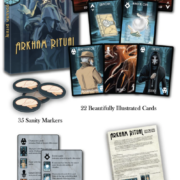Thoughts on Kickstarter #3 – What I look for in the KS page part 2
In my last post, I wrote about the importance of the Kickstarter project image. A beautiful photograph or excellent rendering makes me want to learn more about the project. Now that I have clicked on the project and landed on the project’s main page, I am looking for specific details about the project in a very short amount of time. Let’s see what is important about the project page!
Second topic: 5 most important things in the project page
1. Game description
The very first thing I see on the page should be a brief description of what the project is about. Since I am focusing on the Kickstarter projects for tabletop games, I want a 2 to 3 sentence description of what the game is about. This should include the type of the game (worker placement game, tile-laying game, trick-taking game, etc.), the theme (historic, sci-fi, adventure, Lovecraft, cat, etc.), and some highlights (2-player only game, solo mode, support many players, legacy, etc.). Right underneath the text, there should be some artwork, typically a layout of the components as the game is played, or the game cover, or some game pieces (perhaps miniatures). After reading this part, I should have a decent understanding of whether the game is interesting to me, or it is not for me. If I am confused then typically I lose interest and flag it as not for me.
2. What’s in the box
After learning that the game sounds interesting, I then want to see what I am getting. If there are multiple versions of the game (with and without extra miniatures, or standard and deluxe version), then it should show the components for the version that most people would be interested in. To me, the purpose of this section is to figure out what I am getting for the money I am spending and to see if I like the art style and illustrations. There has been a lot of games where I thought the game looked interesting but I walked away because I didn’t like the art style or vice versa where I was lukewarm on the descriptions but I loved the artwork and bought the game. This and the previous section is sort of like the box back. I grabbed the game off the shelf because the box front (analogous to the project image) looked interesting, and now I am reading the box back.

3. How to play
If I make it to this section, then I am pretty close to being bought. The game sounds interesting and I like the style. Now, I want to really learn how the game works and whether the game mechanics are interesting. I have seen great how to play sections using animated GIFs. The goal of this section isn’t to teach the entire rule of the game, but just to give a high-level overview of what players will be doing. It should have no more than 5 steps, plus maybe a scoring/end of the game section. At the end of the section, I’d like to see a link to a finished (or very close to being finished) rule book. I instantly lose my interest when the rule book link is to an unfinished word document. I’ve also seen a great tutorial video from people like Meeple University and The Rules Girl. These are wonderful as they can teach you the game in less than 5 minutes.
4. Review/Preview Video/Blog
It is always nice to see what other people think about the game and what they liked. I don’t need to see a lot, but not having one, or having “coming soon” is a big negative for me. As for video versus blogs, I like it when there are both types as sometimes I am in a hurry and I don’t want to watch a video. Having a quick summary or a quote from the review is always nice to have. I don’t care too much on how big of a follower the reviewer has as long as the video or the writing is clean and looks professional. I will consider writing about my experiences with reviews and reviewers in a future blog post.
5. Shipping
This is where the bad news is for the backers. I definitely prefer shipping to be included as a part of the campaign. I have done it both ways as a creator and I fully understand the benefit of asking for shipping after the campaign. But I feel that this is a disservice to the backers regardless of how small the shipping cost is. I have turned away from backing the project because not knowing the exact shipping cost ahead of time was too stressful. The project must be really appealing for me to swallow that fear. Having the shipping included in the project and indicating the shipping cost in a table format is, in my opinion, a must-have.
Bonus: Stretch Goals
I put this in here because I tend to not care too much about stretch goals when making my decisions whether or not to back the project. Yes, I like getting more for my buck, but having a ton of stretch goals doesn’t persuade me to back the project. They are strictly a bonus, nice-to-have items, for me. I have seen many projects succeed with no stretch goals and clearly explaining that the game is already at its best shape using the best components for its price point. That being said, I know this is a controversial topic with many different opinions. From a backers perspective, it is probably better to have one than not. At the very least, there should be a section that talks about the stretch goal whether they exist or not.
So here it is. These are what I look for in every Kickstarter project. What are some of the things that are important to you when viewing a Kickstarter page? Tell me in the comments below!








